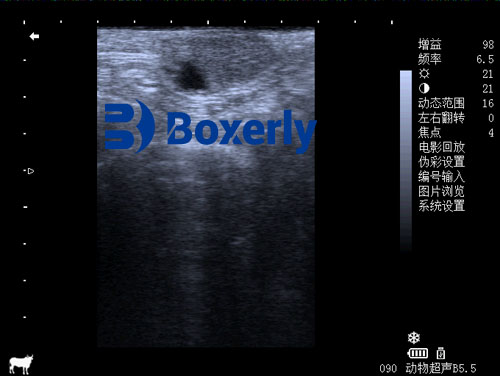Veterinary ultrasound is a non-invasive diagnostic tool used by veterinarians to visualize the internal structures of animals. Just like in human medicine, ultrasound technology has become an essential part of veterinary care, providing detailed imaging that helps diagnose and monitor a wide range of medical conditions. This article will explore the key uses of veterinary ultrasound, highlighting its importance in modern veterinary practice.

1. Pregnancy Diagnosis and Monitoring
One of the most common uses of veterinary ultrasound is to confirm and monitor pregnancies in animals, especially in large animals like horses, cattle, and dogs. Ultrasound can detect pregnancy as early as 20 days in some species, allowing for early intervention if necessary.
During pregnancy, ultrasound is also used to assess fetal health, determine the number of fetuses, and monitor fetal development. It helps veterinarians check for complications like abnormal fetal positioning or placental issues, ensuring the best possible outcomes for both the mother and the offspring.
2. Abdominal Examinations
Veterinary ultrasound is frequently used to examine the abdominal organs, including the liver, kidneys, spleen, bladder, stomach, intestines, and pancreas. Ultrasound provides clear images of these organs, allowing veterinarians to identify conditions such as:
- Tumors or masses: Abnormal growths in the abdominal cavity can be detected and assessed for their size, location, and involvement with surrounding tissues.
- Kidney and bladder stones: Ultrasound can identify stones in the urinary tract and assess the severity of any blockages.
- Liver diseases: Conditions such as liver enlargement, cysts, or tumors can be visualized using ultrasound.
- Gastrointestinal issues: It can also help identify problems like intestinal blockages, thickening of the stomach or intestinal walls, and the presence of foreign objects.
3. Cardiac Examinations (Echocardiography)
Ultrasound is widely used in veterinary cardiology to assess heart health through a procedure called echocardiography. It provides detailed images of the heart's chambers, valves, and surrounding structures. This makes it an invaluable tool for diagnosing and managing conditions such as:
- Heart murmurs: Ultrasound can determine the cause of heart murmurs, whether they are due to valve abnormalities, congenital defects, or other issues.
- Heart failure: By evaluating the heart's function, ultrasound helps veterinarians diagnose heart failure and plan appropriate treatment.
- Pericardial effusion: This condition, involving fluid buildup around the heart, can be diagnosed and monitored using ultrasound.
4. Guided Biopsy and Needle Aspiration
When veterinarians suspect an abnormality, such as a mass or organ dysfunction, ultrasound can guide the biopsy process. Using ultrasound guidance, a veterinarian can accurately position a needle to collect tissue samples or fluid from specific areas. This technique reduces the risks associated with blind biopsies and improves diagnostic accuracy. It is commonly used to collect samples from the liver, kidneys, or masses within the abdomen or chest.
5. Orthopedic and Musculoskeletal Imaging
While X-rays are the traditional choice for evaluating bones, ultrasound plays a critical role in diagnosing soft tissue injuries in animals, particularly those related to muscles, tendons, and ligaments. It’s especially useful for diagnosing injuries in horses, such as:
- Tendon and ligament tears: Ultrasound can help detect tears, strains, or inflammation in these tissues.
- Joint effusions: It is also used to assess swelling or fluid buildup in joints, which can be indicative of underlying injuries or infections.
- Bursal inflammation: Inflammation of the bursae (small fluid-filled sacs that cushion joints) can be visualized using ultrasound.
6. Thoracic Imaging
Although ultrasound is not typically used to image the lungs due to their air-filled structure, it can be helpful in assessing the thoracic cavity for other conditions. It can detect:
- Pleural effusion: Fluid buildup in the space around the lungs can be visualized, helping veterinarians diagnose conditions like pneumonia, heart failure, or cancer.
- Thoracic masses: Abnormal growths in the chest cavity can be detected, providing information for further diagnostic testing or surgical planning.
7. Emergency Situations
In emergency situations, ultrasound can be a life-saving diagnostic tool. It provides rapid, real-time imaging that helps veterinarians assess internal injuries caused by trauma, such as internal bleeding, ruptured organs, or other critical conditions. Point-of-care ultrasound (POCUS) allows for immediate evaluation, often in conjunction with other emergency procedures.
8. Reproductive Health Management
Beyond pregnancy diagnosis, ultrasound is also used in reproductive health management in animals. For breeders, ultrasound can monitor the health of reproductive organs, assess fertility, and diagnose reproductive tract disorders such as cysts, infections, or tumors.
In large animals, such as horses and cattle, it is commonly used in artificial insemination programs to assess the reproductive cycle and ensure optimal timing for insemination.
Conclusion
Veterinary ultrasound is an invaluable tool in modern veterinary medicine. From pregnancy monitoring to cardiac assessments and emergency diagnostics, ultrasound provides crucial insights into an animal's health without the need for invasive procedures. Its versatility, safety, and real-time imaging capabilities make it an essential diagnostic technique in veterinary care.
If your pet or livestock is experiencing health issues, or if you're planning on breeding animals, consult your veterinarian about the benefits of an ultrasound examination. Early detection and diagnosis can make a significant difference in your animal's overall health and well-being.
link: https://www.bxlimage.com/ss/839.html
tags: veterinary ultrasound uses of veterinary ultrasound veterinary diagnostics animal ultrasound echocardiography in animals pet ultrasound








